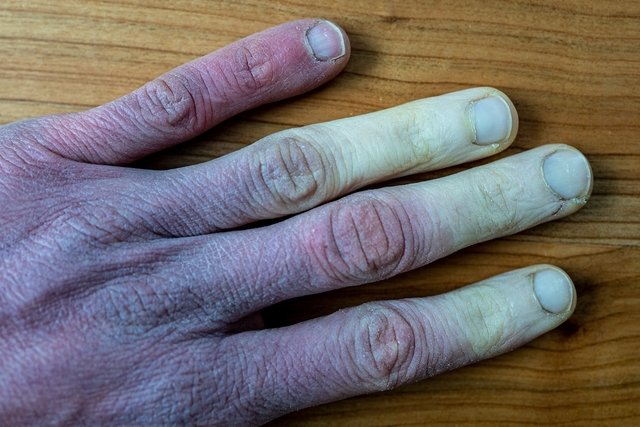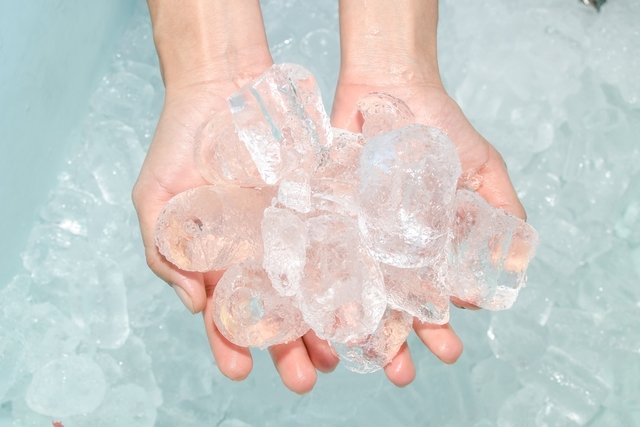Ice burn causes symptoms such as redness of the skin, which can also turn gray or white, a feeling of numbness or tingling, or even the formation of blisters, and affect any place that has come into contact with the ice.
This type of burn can occur through direct contact of the skin with ice for a prolonged period, being more common due to the application of ice packs directly to the skin, without protection and for a long time, but it can also occur due to prolonged exposure to low temperatures and wind. cold.
Frostbite can be treated at home by moving to a warm room or placing the affected area in warm water. However, if it causes hardening or darkening of the skin, numbness, or if it occurs in children or the elderly, it is recommended to go to the emergency room immediately.
Sensitive content
This image may contain content that is uncomfortable for some people.

Frostbite Symptoms
The main symptoms of frostbite are:
- Bright red, white, yellow or grayish skin;
- Pain in the affected area;
- Sensation of numbness or tingling;
- Itching in the region.
The symptoms of frostbite are generally very similar to first-degree burns caused by the sun, when it only affects the epidermis, which is the outermost and most superficial layer of the skin. Know how to identify the symptoms of a 1st degree burn.
However, in more serious cases, blisters may also appear on the skin, as happens in 2nd degree burns, in addition to hardening and darkening of the affected skin. In these cases, you should seek the nearest emergency room immediately.
Don’t ignore your symptoms!
How does ice burn the skin?
When the skin is in contact with ice for a long time, local blood vessels narrow and the flow of blood and nutrients decreases, causing cell damage.
Furthermore, prolonged exposure of the skin to ice causes skin cells to freeze, which results in tissue damage and cell death.
The longer the exposure time to ice, the greater the damage caused to the skin, as it reaches deeper layers of the skin or even muscles, for example.
Does ice burn leave a scar?
Ice burn can leave scars on the skin, which can be permanent if it affects deeper layers of the skin or even muscles, due to cell damage caused by prolonged exposure to ice.
What to do for frostbite
When an ice burn occurs, the recommended first aid is:
- Remove ice from skin immediately and, if the clothes have become wet or cold, remove them as well;
- Soak the skin in the affected area in warm water, at a temperature between 37ºC and 39ºC, for 20 minutes, or take a warm bath. If you feel that your skin is still cold or numb, you can immerse the affected area in warm water for another 20 minutes, leaving an interval of at least 20 minutes between the procedure;
- Go to a warm environment and cover the skin with layers of clothing or a blanket;
- Place warm compresses on the area for 20 minutesif there has been no improvement after immersing the area in warm water;
- Do not rub or massage burned skinto prevent further damage to the skin.
Additionally, it is important to increase water intake, cover the skin with sterile gauze to protect against infections, or apply a moisturizing lotion, such as aloe vera gel, if the skin is intact, that is, without wounds or blisters.
When immersing the skin in warm water, care must be taken to ensure that the water is not too hot, as this may worsen the burn.
Main causes of frostbite
Ice burn can occur due to ice contacting the skin for a prolonged period of time, and is very common due to ice packs applied directly to the skin, without protection and for a long time.
These burns can occur on any part of the body that comes into contact with ice for a long time, such as the face or lips due to ice packs after removing a tooth, for example, or on joints to relieve pain and swelling in the case of of injuries, for example.
Additionally, frostbite can also occur due to prolonged contact with snow, very low temperatures, or very cold wind.
Some factors can also increase the risk of frostbite, such as smoking, diabetes, vascular diseases, peripheral neuropathy or use of medicines to lower blood pressure, for example.
When to go to the doctor
It is important to go to the emergency room in the following cases:
- Hard, cold or numb skin even after warming up;
- Worsening of symptoms or darkening of the skin;
- Blisters on the skin, which may contain pus or green liquid;
- Cracks, wounds or ulcers on the skin;
- Fever;
- Severe non-local pain.
In the case of babies, children or the elderly, regardless of the size of the burn or the intensity of the symptoms, you should always go to the emergency room.
Furthermore, if the burn occurred on the face, lips, neck, palms of the hands, soles of the feet, wrist, buttocks or knees, it is important to go to the emergency room immediately, as these are areas with a higher risk of infection.
How the treatment is carried out
Severe ice burns are treated in the hospital by a general practitioner, warming the affected area and using analgesics to alleviate the pain.
In addition, the doctor should recommend the use of antibiotics if there are signs of bacterial infection in the affected area and medication in the vein to improve blood flow.
If gangrene, which is the death of tissue, occurs, the doctor may perform a procedure called debridement to remove necrotic and infected tissue from the skin to improve healing and prevent the infection from spreading to other parts of the body. See how gangrene is treated.





